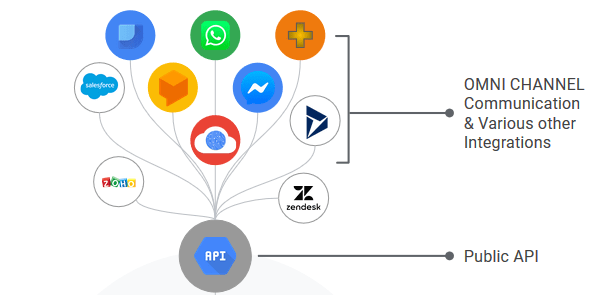It is necessary to understand the evolution of call centers to appreciate modern-day contact centers that are still improving with technological advancements.
Contact centers (traditionally known as Call centers) are an integral unit of a company as they influence the overall perception of how responsible/irresponsible a business is. An industry that doesn’t make its contact center a top priority faces the risk of being left behind as customer demands increase with new advances in technology.
Before we focus on the modern-day contact center evolution, which is omnichannel and AI-driven, we first need to understand the reason for call centers. Let’s take a trip back to the world’s first customer complaint received by a service provider.
In 1750BC, Nanni wrote to Ea-Nasir on a clay tablet complaining about the wrong grade of copper ore delivered to him. The letter written in the Akkadian language, now translated to English, read, “When you came, you said to me as follows: “I will give Gimil-Sin (when he comes) fine quality copper ingots.” You left then, but you did not do what you promised me…”.

Details aren’t available to tell if his request was resolved. However, what is evident is that customer complaint is an age-long occurrence and have continued to increase over the years with the rise of new communication channels.
Discover the best contact center solution partner built on GCP with all of Google cloud’s native functionalities.
Call center vs Contact center
Call centers wouldn’t have been a thing without the invention of the Automatic Call Distributor (ACD) technology in 1960, which was the foundational step towards the call center concept.
 This technology allowed businesses to filter incoming calls and assign them to agents. Also, the introduction of the 0800 toll-free numbers in the 1980s made call centers more accessible.
This technology allowed businesses to filter incoming calls and assign them to agents. Also, the introduction of the 0800 toll-free numbers in the 1980s made call centers more accessible.
In came the internet in the 90s and social media channels in the early 2000s, opening new customer interaction channels through websites, emails, and social media platforms.
This gave rise to the term “contact center,” making available more options for customers to engage businesses, with a relative influx of customer requests through the various channels.
Call centers’ evolution to omnichannel contact centers hinges on businesses’ need to satisfy customer expectations and meet up with technological advancement. So how has the growth of call centers impacted customer experience?
Limited Channel of Communication vs. Omnichannel
In the era of call centers, customers could not reach out to brands through their Choice channels. Phone calls and emails were effective options, and customers had to go through long call queues.
 The shift to Omnichannel communication provided customers with various options for contacting brands – phone, email, chat, text, social media, mobile app, and more. Bots also enable customers to get quick-fix answers to some of their questions outside business hours.
The shift to Omnichannel communication provided customers with various options for contacting brands – phone, email, chat, text, social media, mobile app, and more. Bots also enable customers to get quick-fix answers to some of their questions outside business hours.
Check out how the world’s first and only Google-born contact center solution can make you an industry champion!
On-premise to Cloud-based contact centers
Unlike a traditional call center experience, which is On-premise based, a Cloud-based contact center experience allows for easy scalability of agents, which is a great feature to manage a surge in customer requests.
It also allows quick and easy integrations with third-party applications such as CRM, ERP, and many applications such as WhatsApp Business and Facebook Messenger.
With a complete cloud solution, most of these integrations are built-in, thus easing customer service delivery and enhancing customer experience.
Automatic Call Distribution (ACD) to Skill-based routing
Traditional ACDs push inbound calls to the next available agent, while skills-based routing ensures that an inbound call is routed to a qualified and efficient customer support agent.
This way, the best-fit agent based on skillset is assigned to a caller, giving a personalized contact center customer experience.
Office agents to Remote agents
The adoption of cloud contact center technology has given rise to remote agents and an expanded capacity for contact center operations. In the past, call center agents were required to work primarily from an office space, which usually came with a cost such as rent, crowded areas, and noisy environments.

Today, with the challenges of the COVID-19 pandemic, more agents are working remotely, helping to meet niche industries’ staffing requirements and enhancing customer experience.
Customer journey tracking
Through a study of interaction across various channels (email, chat, calls, social media), contact centers can understand users’ needs and deliver a better request resolving experience.
Traditional call centers couldn’t track customer journeys as there was a limitation to insight on customer interaction across service touchpoints.
Having a Google-native contact center is a game-changer! Discover how the world’s third biggest university managed high demand periods.
Reactive vs. Proactive
With tools such as Dialogflow, contact center agents are more proactive and efficient in responding to customer requests. When a customer calls your business, Dialogflow takes over by identifying customer intent from a transcribed text and matches it to the best-fit reply for your agent to say or take action.
Traditional call center agents didn’t have this luxury, as they had to read up a lot of information about a product and would most times require customers to call back to resolve issues.
Customer satisfaction metrics redefined

Call centers measured customer satisfaction by how quickly an agent answered the phone and responded without considering if the request was resolved. This led to agents having a hasty approach towards resolving requests, often leaving the customer unsatisfied.
This has changed with the modern-day contact centers with metrics such as first-contact resolution, chat rating, the average time in queue, average call abandonment rate, average handle time, etc. Businesses can now track how best agent customers are being attended to and iterate proactively to meet expectations.
The debate on contact center vs call center could always be subjective depending on the needs of your business. However, to be where your customers want to reach you would require the adoption of a contact center operations approach.
We offer a free consultation session to discuss any questions you may have about setting up and managing the best contact center for happier customers. Feel free to schedule a quick chat.




